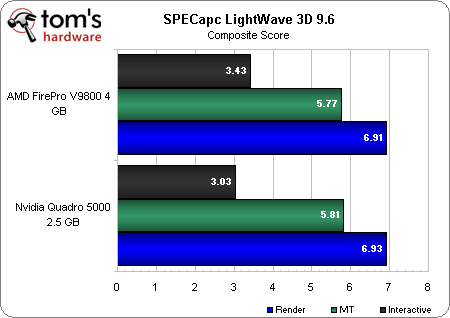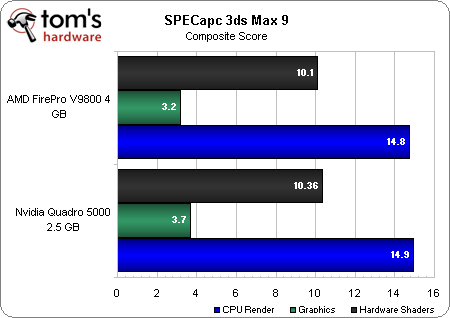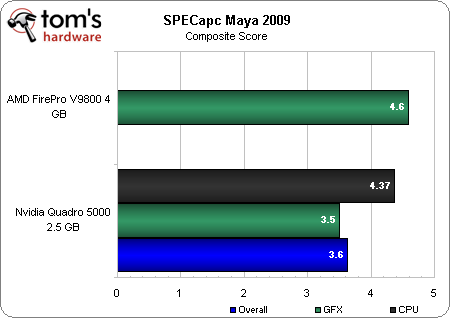AMD FirePro V9800 4 GB: Eyefinity Meets Professional Graphics
What's red, black, sports 4 GB of GDDR5, and has DisplayPort outputs all over? AMD's FirePro V9800, the company's ultra-high-end workstation card. We run it through a battery of SPECapc and real-world performance tests, then compare it to Quadro 5000.
Benchmark Results: SPEC
| SPECviewperf 11 | AMD FirePro V9800 | Nvidia Quadro 5000 |
|---|---|---|
| catia-03 | 15.00 | 44.57 |
| ensight-04 | 24.31 | 38.13 |
| lightwave-01 | 49.86 | 65.53 |
| maya-03 | 64.22 | 67.32 |
| proe-05 | 4.85 | 10.83 |
| sw-02 | 38.88 | 61.27 |
| tcvis-02 | 23.43 | 38.86 |
| snx-01 | 26.49 | 39.31 |
A heads-up battle in SPECviewperf 11 seems pretty bad for the FirePro card, even with AMD’s latest drivers. Things actually look a lot better for AMD than they did in our FirePro V8800 review, true. But Nvidia still walks away with a victory in each of the disciplines tested.
SPECapc LightWave 9.6
The interactive and render tests are run sequentially, generating both scores. The MT (multi-tasking) test sees the interactive and rendering tests executing concurrently.
Nvidia’s Quadro 5000 takes a small lead in the render and multi-tasking test, but the interactive benchmark favors AMD’s solution—something we saw in Uwe’s FirePro V8800 review as well.
SPECapc 3ds Max 9
| SPECapc 3ds Max 9 | AMD FirePro V9800 | Nvidia Quadro 5000 |
|---|---|---|
| Wireframe Graphics | 2.09 | 2.04 |
| Mixed Wire/Shade GFX | 2.89 | 2.98 |
| Shaded Graphics | 4.33 | 4.53 |
| Hardware Shaders | 10.11 | 10.36 |
| Graphics, Texturing, Lighting, and Blending | 2.42 | 3.74 |
| Inverse Kinematics | 2.96 | 3.12 |
| Object Creation, Editing, and Manipulation | 4.00 | 4.03 |
| Scene Creation Manipulation | 4.52 | 3.75 |
| Rendering | 14.76 | 14.92 |
The CPU render and hardware shader tests are close, even if each favors Nvidia. The graphics benchmark is much more pronounced, going in favor of Nvidia’s Quadro 5000 card.
SPECapc Maya 2009
Get Tom's Hardware's best news and in-depth reviews, straight to your inbox.
Using the latest drivers, AMD’s FirePro V9800 was unable to finish the entire SPECapc Maya 2009 suite, returning zeros for the latter portion of the test, which resulted in the CPU and I/O portions failing. Thus, all we have here is a graphics score. The good news is that AMD’s score is much higher than Nvidia’s. The bad news is that there’s no overall composite score to compare, since the FirePro doesn’t complete the test.
Now, the challenge with any of the SPEC tests is that they’re based on old versions of applications that get updated every single year. None of the latest trends in software development get taken advantage of, potentially leaving performance on the table. Unfortunately, the member organizations that make up SPEC seem to move slowly (gasp—bureaucracies are horribly inefficient?), so the snapshots of workstation graphics come with a time delay.
We were marginally successful getting a handful of other workstation-class apps running, but were amazed to find how many of these tasks are CPU-limited…
Current page: Benchmark Results: SPEC
Prev Page Test Setup And Benchmarks Next Page Benchmark Results: Adobe CS5 Suite-
Nvidia shines in the industrial/commercial/scientific market, with their driver team and CUDA/GPGPU tech. Too bad the V9800 fell short of expectations. Also, Nividia cards are obviously going to have better results in Adobe Mercury since both companies worked together on hardware optimization. AMD needs to be more aggressive in working together with software makers, (including games!) to have a stronger hold on both the CPU and GPU markets. Overall, a good read.Reply
-
reprotected It would actually make sense if they compared with the V8800 and the Quadro 6000. We also need a review of the Quadro 4000, 2000 and the 800, along with the lower Firepro 3D series.Reply -
reprotectedIt would actually make sense if they compared with the V8800 and the Quadro 6000. We also need a review of the Quadro 4000, 2000 and the 600, along with the lower Firepro 3D series.1. Definetly, a review of the "lower end" cards would be nice.Reply
2. Plus, it would be nice to see how well the SLi cards scale.
3. Also, with the updated (e)nVidia desktop cards (GF100 to GF110), will the Quadro ones see a revision too - if so, when? -
cangelini radiovan1. Definetly, a review of the "lower end" cards would be nice.2. Plus, it would be nice to see how well the SLi cards scale.3. Also, with the updated (e)nVidia desktop cards (GF100 to GF110), will the Quadro ones see a revision too - if so, when?Reply
Good question (3), I'll ask!
Cheers,
Chris -
Cwize1 This was a rather underwhelming test suit. I think the fundamental problem you have is that most of the tests you ran were CPU based.Reply
What most of these production apps use the GPU for is on the fly rendering. For example, sculpting in blender can tax the GPU quite nicely given enough vectors. Another good blender one would be playing back a super resolution baked fluid simulation in real time. For example, take the tom's hardware logo you had before, turn it into water and let the water fall onto a flat surface. Bake the simulation with a ridiculous resolution (as much as you can before blender crashes) and then play the simulation back in real time while watching 5 high definition videos at the same time. -
hell_storm2004 The FirePro has still the long way to go to catch up with the Quadro. I hope ATI makes good progress in the workstation models soon like they have come a long way in the desktop market.Reply -
eclecticfortune In this article's conclusion appeared this statement:Reply
"If you’re a creative professional working with Adobe’s CS5 suite, then the Quadro is hands-down a no-brainer."
Benchmarks indicate that the lower priced GTX 480 is a far better choice (cost effective)for those taking advantage of the Mercury Playback Engine running Premiere Pro CS5.
http://ppbm5.com/Benchmark5.html
At the top of this page, click on the "MPE Performance Chart" to get a comparison between the different Nvidia Cards with Premiere Pro CS5.



